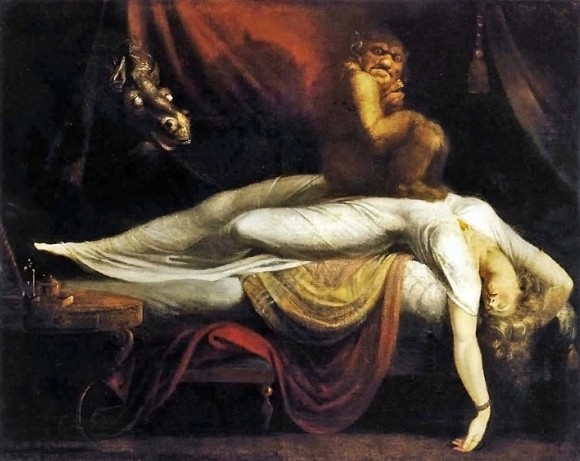
A guest post by author Matt Cardin. When I first started experiencing sleep paralysis attacks accompanied by visionary assaults from a shadowy demonic presence in the early 1990s, I was already a long-time fan and student of supernatural horror. I had grown up enthralled by horror stories, novels, and movies, as well as by nonfiction explorations of supernaturalism and the paranormal. I was also intrinsically interested in religion and spirituality. So perhaps it was predictable that my sleep paralysis encounters would hit right in the middle of all this and produce some profound emotional and philosophical effects. But what startled me as much as anything was the recognition, which didn’t arise until more than a decade later, that there already existed a kind of master visual image that united this network of concerns and sat at its center, acting as a nexus of nightmares and emitting cultural, psychological, and spiritual waves of dark inspiration.
I first noticed these connections a couple of years ago as I was browsing through my copy of Great Tales of Terror and the Supernatural, the classic, genre-defining collection of horror and thriller stories edited by Herbert Wise and Phyllis Fraser (later Phyllis Cerf Wagner) for the Library of America. First published in 1944, the book changed my life in the 1980s when I stumbled across it in the library of my tiny rural Missouri high school and was introduced to H.P. Lovecraft via his “The Rats in the Walls” and “The Dunwich Horror.”
 Fast forward two more decades, and there I was, standing in front of the bookshelves in my home and browsing through my own well-worn copy of the book, when suddenly I noticed for the first time the significance of the image that had been chosen by the publisher to appear on the cover of the fiftieth anniversary edition in 1994. It was a cropping of the 1790 version of Fuseli’s iconic “The Nightmare.” Not a strange choice, clearly. In fact, it was quite an obvious one, not only because of the painting’s centrality to the history of the horror genre (regarding which, see below) but because one of the stories in the book, Guy de Maupassant’s “The Horla,” describes supernatural sleep-assaults of the kind represented in the painting.
Fast forward two more decades, and there I was, standing in front of the bookshelves in my home and browsing through my own well-worn copy of the book, when suddenly I noticed for the first time the significance of the image that had been chosen by the publisher to appear on the cover of the fiftieth anniversary edition in 1994. It was a cropping of the 1790 version of Fuseli’s iconic “The Nightmare.” Not a strange choice, clearly. In fact, it was quite an obvious one, not only because of the painting’s centrality to the history of the horror genre (regarding which, see below) but because one of the stories in the book, Guy de Maupassant’s “The Horla,” describes supernatural sleep-assaults of the kind represented in the painting.
But this very fact, as well as the fact that de Maupassant’s descriptions of demonic attacks have been recognized in recent years as fictionalized accounts of his own sleep paralysis experiences, struck me with a previously unrecognized depth of significance as I stood there before my bookshelves on that particular day. And pretty soon, in a matter of minutes, I realized that something truly profound lurked in this nexus of nightmares both “fictional” and “real.” What’s more, I recognized that my own library bore witness to this weirdness.
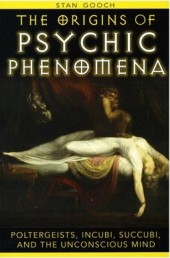 For right there on another shelf sat my copy of Stan Gooch’s The Origins of Psychic Phenomena: Poltergeists, Incubi, Succubi, and the Unconscious Mind. Gooch was a kind of renegade researcher into the confluence of psychology and paranormal phenomena, having begun his career in the mid-20th century as a mainstream psychologist for the British government before experiencing a profound change of course when he reluctantly attended a séance at the invitation of a friend and experienced a spontaneous and shocking episode of trance channeling. He spent the rest of his life exploring the bizarre doubleness of human consciousness as it relates to the questions of paranormal powers and supernatural entities.
For right there on another shelf sat my copy of Stan Gooch’s The Origins of Psychic Phenomena: Poltergeists, Incubi, Succubi, and the Unconscious Mind. Gooch was a kind of renegade researcher into the confluence of psychology and paranormal phenomena, having begun his career in the mid-20th century as a mainstream psychologist for the British government before experiencing a profound change of course when he reluctantly attended a séance at the invitation of a friend and experienced a spontaneous and shocking episode of trance channeling. He spent the rest of his life exploring the bizarre doubleness of human consciousness as it relates to the questions of paranormal powers and supernatural entities.
In The Origins of Psychic Phenomena, he presented a fairly in-depth examination of the subjects mentioned in the subtitle, and this naturally involved some discussion of visionary nocturnal assaults and sleep paralysis. He also touched briefly on the supernatural horror genre and the phenomenon of inspired artistic and authorial creativity. And the cover of the book, both when it was published under its current title and when it originally appeared as Creatures from Inner Space, was, yes, Fuseli’s “The Nightmare.”
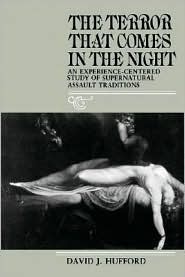 Pretty soon I found myself pulling other books from the shelf and lining them up for comparison. The effect was fairly startling. Great Tales of Terror and the Supernatural and The Origins of Psychic Phenomena were joined by, of course, David Hufford’s The Terror That Comes in the Night: An Experience-Centered Study of Supernatural Assault Traditions, the book that reintroduced the experience in question to the modern secular mind as a matter of above-board recognition and research. Fuseli’s squatty little gargoyle-demon, crouched on the breast of the swooning, paralyzed woman, leered at me from its cover as well.
Pretty soon I found myself pulling other books from the shelf and lining them up for comparison. The effect was fairly startling. Great Tales of Terror and the Supernatural and The Origins of Psychic Phenomena were joined by, of course, David Hufford’s The Terror That Comes in the Night: An Experience-Centered Study of Supernatural Assault Traditions, the book that reintroduced the experience in question to the modern secular mind as a matter of above-board recognition and research. Fuseli’s squatty little gargoyle-demon, crouched on the breast of the swooning, paralyzed woman, leered at me from its cover as well.
Next came Christopher Frayling’s Nightmare: The Birth of Horror, the book published in conjunction with Frayling’s 1996 BBC series of the same title.
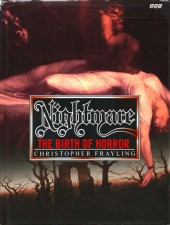 I had only just acquired it, and it was probably the pressure of that book on my subconscious that was producing this conscious mini-burst of newly drawn connections. For Frayling’s fascinating point in both the book and the television series is that the mainstream of the horror genre itself, as represented by four key works — Frankenstein, Dracula, Dr. Jekyll and Mr. Hyde, and The Hound of the Baskervilles — has been driven right from the start by the authors’ own experiences of nightmares, and that this is all connected to, and has in fact directly stemmed from, Fuseli’s presiding portrait of the archetypal nightmare encounter, which the young Mrs. Shelley incorporated both consciously and unconsciously into her novel.
I had only just acquired it, and it was probably the pressure of that book on my subconscious that was producing this conscious mini-burst of newly drawn connections. For Frayling’s fascinating point in both the book and the television series is that the mainstream of the horror genre itself, as represented by four key works — Frankenstein, Dracula, Dr. Jekyll and Mr. Hyde, and The Hound of the Baskervilles — has been driven right from the start by the authors’ own experiences of nightmares, and that this is all connected to, and has in fact directly stemmed from, Fuseli’s presiding portrait of the archetypal nightmare encounter, which the young Mrs. Shelley incorporated both consciously and unconsciously into her novel.

Witness, for example, her description of Elizabeth’s death scene, with Elizabeth fallen backward across the bed while the monster stands over her; Mary explicitly modeled this tableau on Fuseli’s painting, and the same mise en scène was later recreated by director James Whale in Universal’s 1931 Frankenstein. Likewise recall Victor Frankenstein’s awakening from a nightmare to find his monster standing over him and watching from the window.
Then factor in the visionary origin of Frankenstein in Mary’s famous “waking dream,” which many today recognize as a likely episode of sleep paralysis. (Also note that her much-disputed account of this was given a dose of scientific credence last year when a team of astronomers conducted measurements at the Villa Diodati, where Mary spent her famous summer of ghostly inspiration and conversation in 1816, and confirmed her description of the moon’s appearance and location on the night of her vision.)
Frayling’s research hones in on the horror genre’s basis in nightmares, and on the role of Fuseli’s painting as the genre’s master image, in brilliant fashion. But in the midst of it all, he completely misses the fact that the word “nightmare” refers not just to a bad dream but to a wakeful visionary encounter with what’s perceived as a real presence. In other words, he writes in ignorance of the fact, which has now been reclaimed from a long span of historical amnesia, that the generally accepted meaning of the word in current usage represents a distinct transformation and, as many of us would argue, misleading devolution from its true significance.
The word “nightmare” was originally coined to refer to what we today call sleep paralysis with hypnagogic and hypnopompic visions, and this means that Frayling was getting at far more than he even knew or intended when he traced the genre’s origins to Fuseli’s painting, Mary’s waking nightmare, and the growing culture-wide ferment and foment at the turn of the 19th century that involved science, religion, art, literature, ideas about creative inspiration, and the growing recognition that the conscious “daylight” mind is accompanied and influenced – and is also, as shown in both nightmares and horror tales, menaced — by a subconscious or unconscious “nightside” realm of dreadful entity.
[pullquote]The word “nightmare” was originally coined to refer to what we today call sleep paralysis with hypnagogic and hypnopompic visions.[/pullquote]As I say, the threading together of these various matters by Fuseli’s master image, which now presides not only over the horror genre but over the realm of sleep paralysis studies as well, struck me all at once and with considerable force as I stood there at my bookcase two years ago, and the strength of its impact was bound up with my personal living out of the realities in question.
I’m not only someone who has experienced sleep paralysis in conjunction with supernatural(-seeming) assaults, but someone who has been driven by these experiences to write supernatural horror fiction.
My long-time love of the genre mutated into a driving desire and inspiration to contribute to it when my horrified nights began leaching over into days that were similarly full of a creeping metaphysical dread. It was as if a hole had been punched in the cellar of my psyche, and all kinds of previously unsuspected and/or inchoate insights and moods and realizations came flooding up to alter my basic worldview and sense of psychic centering. With them came both an urge to write and a darkly flaming set of ideas for writing, and the whole thing coalesced over time into the sense of a daemonic muse whose identity, as I have been led to suspect for nearly two decades now, is none other than that burning, sizzling shadow-figure that came to torment me over a span of years.
 But it wasn’t until a couple of years after my epiphany at the bookshelves — which is to say, it wasn’t until earlier this year — that the whole thing reached a kind of spiritual-synchronistic apex. When Shelley Adler’s book Sleep Paralysis: Night-Mares, Nocebos, and the Mind-Body Connection came out last year, I, like everybody else who is at all interested in sleep paralysis, knew that I would have to read it. But my purchase was delayed, and I didn’t get it until this year.
But it wasn’t until a couple of years after my epiphany at the bookshelves — which is to say, it wasn’t until earlier this year — that the whole thing reached a kind of spiritual-synchronistic apex. When Shelley Adler’s book Sleep Paralysis: Night-Mares, Nocebos, and the Mind-Body Connection came out last year, I, like everybody else who is at all interested in sleep paralysis, knew that I would have to read it. But my purchase was delayed, and I didn’t get it until this year.
When I finally acquired a copy and sat down to read it a few months ago, I did so with a truly delectable sense of anticipation. And of course there was Fuseli’s “Nightmare” staring at me from the cover, confirming the entire network of converging and interlinking ideas, influences, and epiphanies that had come to characterize my journey through the intertwined worlds of spiritual experience, paranormal realities, existential horror, and supernatural horror fiction.
Dr. Adler’s presentation proved to be fully as engaging as I had hoped, especially when I reached the point in Chapter 2 where she discusses Fuseli’s painting, Mary Shelley’s dream, Frankenstein, and other works of art and literature that have obviously arisen from or otherwise been connected with sleep paralysis.
I was savoring it all with great pleasure, and then I turned to read the chapter’s endnotes. The last one, note 15, was connected to a sentence in the chapter that read “The night-mare is not restricted to fiction, however, but also appears in other works.” The note itself started with Adler’s observation that “A few brave authors recounted their personal experiences” with sleep paralysis and its attendant phenomena.
She went on to share a passage from Sir Arthur Conan Doyle’s The Edge of the Unknown. Then she concluded by stating, “Even today, there are writers who attribute their literary inspiration to the night-mare,” as illustrated by a quote from another author’s experience:
‘My mature birth as a writer can actually be attributed in some measure to these sleep disruptions. . . . It was the changes that these episodes wrought upon my overall sense of psychic stability that led to my mature efforts at fiction writing. The pervasive mood of absolute, unbearable terror and horror that characterized many of my nights began to seep into my daylight hours and plague me with fears that I might be losing my mind. . . . Sleep paralysis is the most dreadful thing you can imagine. The term “soul-searing” comes to mind but hardly does it justice. The sense of terror, and sometimes horror, and sometimes both, that accompanies it is literally unendurable. I wouldn’t wish the experience on anybody. But at least it provides useful grist for the mill; you’re more likely to write a decent horror story when your entire life has been overtaken to some degree by the pure, unmediated experience of horror itself.'”
Upon beginning to read this passage, I instantly felt confused. Why did these words seem so familiar? Where had I read them before? Then I reached the end and saw the parenthetical citation: “(Cardin 2006).” A kind of cold electrical jolt lanced through my gut. I flipped to the bibliography, scanned the contents, and found that Ms. Adler had taken the passage from a 2006 blog post in which I described my own experiences and how they had inspired and shaped my writing.
So there I sat, reading yet another book featuring Fuseli’s iconic magnum opus on the cover, and enjoying the author’s learned and valuable exploration of sleep paralysis and its meaning for psychology, selfhood, society, art, religion, creativity, and the mind-body connection, and now I was seeing that my own self-described experiences had been drawn into this vortex of obscure but magnetic and mesmerizing meanings that had come to define my life experience.
When I closed the book and stared again at the cover, I couldn’t escape, at least for a moment, the impression that Fuseli’s squatty little nightmare demon was staring out not just at the generic “viewer” of the image but at me personally, and that it was leering with the smug knowledge of some profound secret that is vital to my existence, but that I will go to my grave without having known, because it will never allow me to learn it.
——————————————————————————-
About the Author
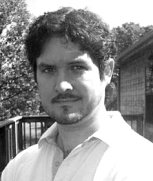 Matt Cardin is the author of Dark Awakenings, Divinations of the Deep, and the forthcoming To Rouse Leviathan and Daemonic Creativity: A Guide to the Inner Genius. He founded and edits The Teeming Brain, a blog about the apocalyptic intersection of horror, religion, the paranormal, creativity, consciousness, and culture. His author site is www.mattcardin.com.
Matt Cardin is the author of Dark Awakenings, Divinations of the Deep, and the forthcoming To Rouse Leviathan and Daemonic Creativity: A Guide to the Inner Genius. He founded and edits The Teeming Brain, a blog about the apocalyptic intersection of horror, religion, the paranormal, creativity, consciousness, and culture. His author site is www.mattcardin.com.
Hi Matt,
I enjoyed reading your post.
I would like to inform you, that the Swiss painter Johann Heinrich Füessli (the Americans call him Fuseli, I know 😉 painted several versions of his famous painting. The cover of “the great tales of terror and the supernatural” is a less known and darker version.
Greetings from Switzerland
Christoph
Many thanks, Christoph. Yes, the choice by Library of America to use the 1790 version instead of the more commonly reproduced 1781 version is interesting. The later one is indeed darker — which leads me to wonder whether Fuseli/Füessli’s own experience and/or understanding of the experience being portrayed grew more dark and harrowing over time. Something to dig into with future studies, perhaps.
Matt, what a great post–and thanks for including my Sleep Paralysis book. I was so happy when I came across your 2006 blog post on the role of SP in creativity and writing. You described the connection so beautifully and compellingly, I had to quote you. Sleep paralysis is endlessly fascinating to me, not just because of the impact of the experience itself, but because of how it draws us together.
Best wishes,
Shelley
It’s a fine thing to meet you, Shelley, and I’m glad you appreciated both my current post and the one from 2006. You can probably tell from what I said above that your sleep paralysis book hit me hard, and not just because of the included quote from me. Thank you for giving us all such a fine and valuable exploration of the subject. It has been amazing to me to discover the truth of what you say about SP bringing us together, especially since the phenomenon’s eruption in my life generated a progressively more profound sense of being trapped in a private nightmare. It feels like a different world now that the subject is an above-board matter of widespread recognition and discussion.